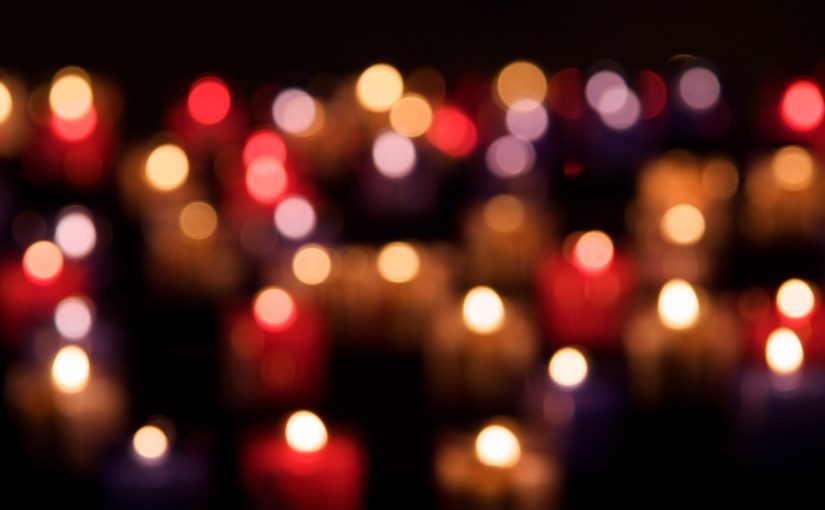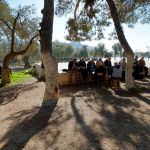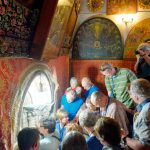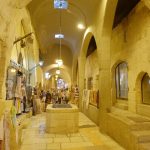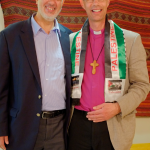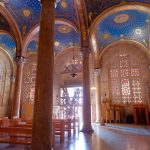I must have spent too much time this summer in churches and it has left me wondering what they’re for. I know what I think they are for but it is perfectly apparent that different people have different ideas.
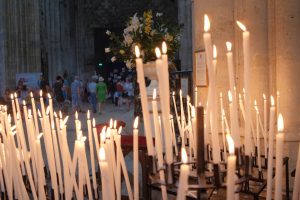
I caught an image of votive candles in Bordeaux Cathedral whilst tourists walked by. Some had come to light a candle and say a prayer, others to look at medieval architecture; some to consider history and others to look at the art; some to find shade from the heat of the sun and others to take photos; and for some, all of the above. The picture sums it up.
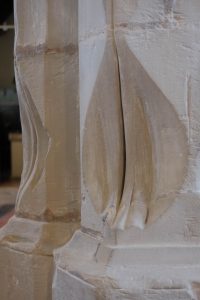
Back in Leicester, over a relaxed August, the DAC had a day out to visit some churches it has an interest in. The scars on the pillars at Dunton Bassett church tell us that this was once a good place for sword sharpening!
These things just serve to provide a glimpse of the competing expectations those who are responsible for church buildings are confronted with. The fundamental mission of the church, which is the people of God, is to draw the whole of creation into the love and worship of God. Among the many ways that our buildings can serve this are the magnificence of architecture pointing to the heavens, imagery and artwork telling the stories of salvation and the symbols of prayer, word and sacrament.

But this can become a millstone too. When the church community that is responsible for an historic church can no longer adapt it to the needs of their neighbours, the vitality of the building is neutralised. And if a church community is not able to use the building they have inherited to serve their mission, they should perhaps chose to direct their money and energies somewhere else.

The history of our many ancient listed church buildings is one of constant change and adaption to the needs of society. What we see carved in the stones is the constantly changing means the Christian community has used to present faith to its neighbours with authenticity and relevance. But today it seems different. Local churches do not have a free hand in what they do. The other interests in play often have more concern for conserving or preserving what has pervaded in the past than serving a living faith in the present. So we often encounter contention about such matters as:
- The introduction of a kitchen and toilet – twenty-first century hospitality basics, although they were luxuries in the early twentieth century.
- Replacement of pews with flexible seating – the structure of Victorian society neatly set out in rows no longer pervades. People relate differently today. A colleague recently quipped, “Christians are not like carrots – they don’t grow in rows – Christians grow in circles.”
- Improved heating and lighting – contemporary people are not familiar with wearing coats indoors, yet at the same time are more conscious of the financial and environmental cost of energy than their predecessors. Heating hundreds of gallons of water to keep a church warm and burning incandescent light bulbs is no longer acceptable.
- Use of high value metals such as lead and copper for roofs. Stainless steel and plastic membranes have many advantages although they are not traditional materials.
- Installation of audio visual facilities.
- Updating decor and softening the floor and furnishings.
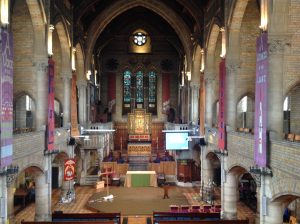
I wonder what sometimes is being conserved. When we preserve the stones of a building we can do so at the expense of the purpose for which they were hewn. These were often radical and extravagant public buildings that innovated and challenged the mores of their day. Bodies that today oppose their ongoing development should ask themselves whether this is in the spirit of that which inspired them.
Of course church communities themselves can also misunderstand the nature of the building for which they are responsible. I once visited a church where a curtain had been strung across the arch between the nave and the chancel. The Victorian Choir and Sanctuary served as a storage space for a lawn mower and step ladders. The congregation met in the nave. This seemed to me to represent too many violences to the building to even count. How would any visitor read what is important here?
In a little book from 1979 (1), Harold Turner discerns two fundamental patterns for sacred buildings:
Domus Dei – House of God, and
Domus Ecclesiae – Meeting house.

Many of our churches with Victorian interiors, whether they are medieval or nineteenth century buildings, are conformed entirely to the former pattern. The raised chancel and sanctuary with an altar at the east end serves to locate the presence of God in the place where Communion is celebrated. But the contemporary church is growing most noticeably where people meet in good relation with each other and experience the presence of God in their daily lives. Perhaps church buildings need only be a meeting house to serve this growth. Turner sees the most developed forms of sacred space as both (Domus Dei et Ecclesiae). The story is not one of compromise but of building on what others have done with respect. Maybe this is the spirit today’s church and conservation lobbies need to recapture.
(1) Turner, Harold, From Temple to Meeting House: The Phenomenology and Theology of Places of Worship (The Hague: Mouton Publishers, 1979).

